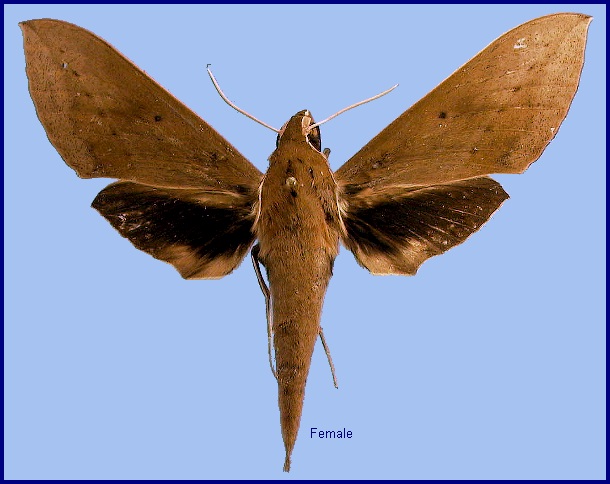

Sphinx boisduvalii Bugnion, 1839, Ann. Soc. ent. Fr. 1839: 113. Type locality: [Greece,] Île de Candie [Crete].
Synonym. Sphinx boisduvalii Bugnion, 1839.
Synonym. Chaerocampa punctivenata Butler, 1875, Proc. zool. Soc. Lond. 1875: 248.
Note. Cechenena sumatrensis Joicey & Kaye, 1917, Ann. Mag. nat. Hist. (8) 20: 307, previously included within Theretra boisduvalii, is now regarded as being a good species, namely Theretra sumatrensis (Joicey & Kaye, 1917).
Wingspan: 84--110mm. Not very variable. Immediately distinguished from Theretra alecto by its dark brown forewing and blackish hindwing, but very similar to Theretra clotho clotho; however, fourth postmedian line faint, accentuated by vein dots. Abdomen upperside usually with five lines, rarely completely absent, the middle one the faintest. Forewing upperside with six faint postmedian lines, the fourth usually highlighted by vein-dots. Hindwing upperside with buff median band reduced compared to Theretra clotho clotho.



Frequents edges of woodland and cultivated areas where species of Vitaceae grow.
Very little is known about the behaviour of this species except that it is strongly attracted to light and flowers.
China: 30.v (Hainan); 13.vi (Yunnan); vii (Hong Kong); 13.viii (Hong Kong). Taiwan: v (Kaohsiung Hsien; Nantou Hsien); 10-14.vii (Pingtung Hsien); 15.ix (Pingtung Hsien).
OVUM: Pale green, oval (2mm), shiny and smooth. Large for the genus.
LARVA: Very like that of Theretra alecto.
PUPA: Very like that of Theretra alecto.
Larval hostplants. Not known for China, but Vitaceae elsewhere, e.g. Vitis and Parthenocissus.
On Taiwan recorded from Ampelopsis cantoniensis, Causonis japonica [syn. Cayratia japonica], Cissus verticillata [syn. Cissus sicyoides], Leea guineensis and Tetrastigma hemsleyanum [syn. Tetrastigma bioritsense].
Unknown.
China: Yunnan (nr. Yingjiang, Xima, 2080m; Gaoligong Shan; Dawei Shan; Xishuangbanna; Simao/Pu'er); Xizang/Tibet (Mutu, 850m); Guangdong (Wentang; Shangshuitian); Hong Kong; Hainan (Longhushan, Wenchang City; Wuzhi Shan; Baotie; Shitian Gate).
Taiwan: Pingtung Hsien (Kenting); Kaohsiung Hsien (Shanping, 640m); Nantou Hsien (Puli); Taipei Hsien (Wulai); Hualien Hsien (Hungyeh).
Essentially a tropical species with occasional vagrants to the north and to 900m altitude in the Himalaya.
From south-eastern Iran eastwards across tropical India to Sri Lanka, and on through Thailand, Laos, southern China, Vietnam (Le & Vu, 2024) to Taiwan and south to Indonesia (Kalimantan and Lombok).
A very rare vagrant west to Turkey and Greece, but no individuals have been recorded from Europe in recent years. (As Theretra boisduvalii and Theretra alecto have both shared the name cretica, it may be possible that 'records' of this species from Europe are due to misunderstanding.)

Palaeotropical; Oriental region.
 Return to Sphingidae of the Eastern Palaearctic species list
Return to Sphingidae of the Eastern Palaearctic species list